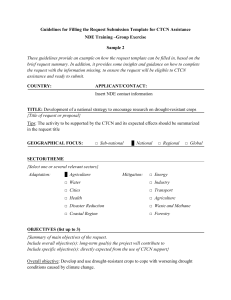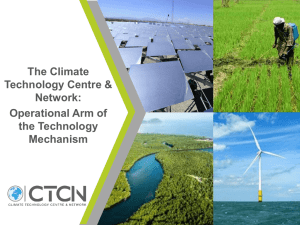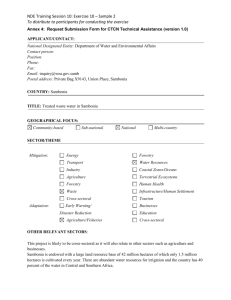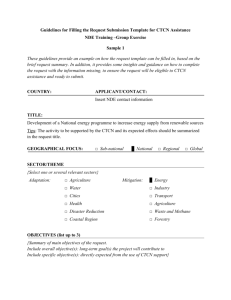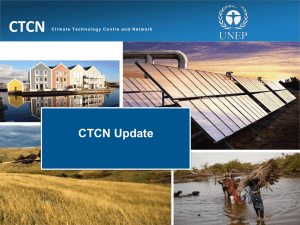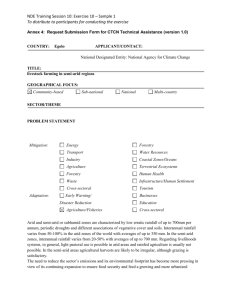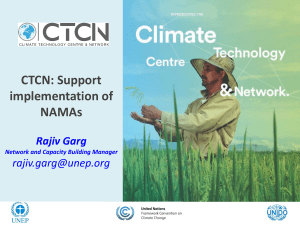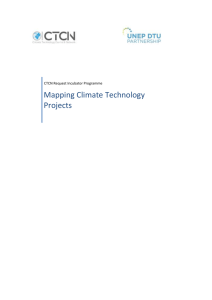Diapositive 1 - Climate Technology Centre & Network
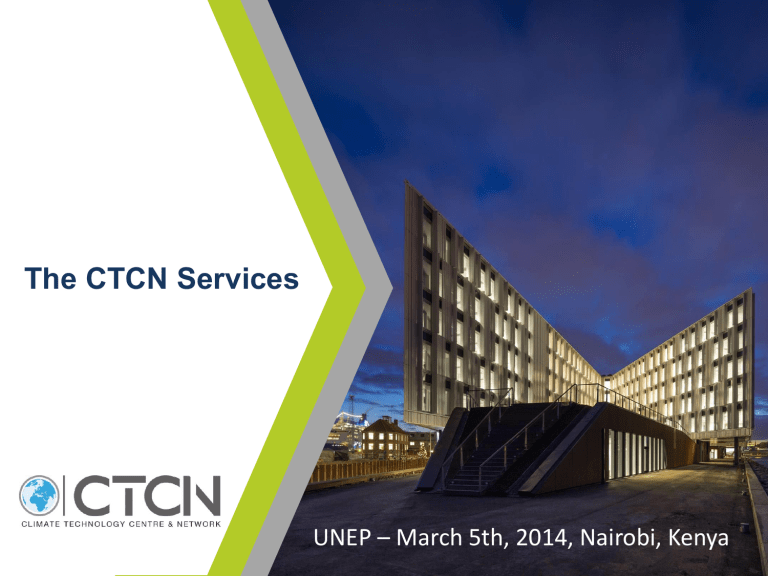
The CTCN Services
UNEP – March 5th, 2014, Nairobi, Kenya
Outline of the Session
• Individual exercise
• Presentation of CTCN services
• Group exercise
Objectives of the Session
Understand what services the CTCN can and cannot provide
Understand CTCN mission and objectives to support transfer of technologies
Understand how an NDE can support the CTCN in the delivery of its services
Be able to advise country stakeholders on what the
CTCN does
Individual Exercise
Exercise Guideline
Duration: 10 minutes
Material: Sticky notes
Each participant writes on sticky notes what are their current understanding and expectations related to the CTCN services.
Participants can use concrete examples on the kind of support they would like to have, and what they expect from the
CTCN.
Presentation:
The CTCN Services
Presentation Outlines
• Objective of CTCN services
• Approach of CTCN services
• Areas of CTCN services
• Definitions
• Specific Services, the Menu
Objective of CTCN Services
Support the identification, use and widespread deployment of environmentally sound technologies in developing countries by:
Removing barriers hindering transfer of technologies
Enabling informed choices about climate technologies
Approach of CTCN Services
• Catalytic
• Country-driven
• Capacity-builder
• Collaborative
• Responsive
Areas of CTCN Services
Three core services:
1. Provide technical assistance to developing countries to enhance transfer of climate technologies
2. Provide and share information and knowledge on climate technologies
3. Foster collaboration and networking of stakeholders on climate technologies
Overview of CTCN Services
Climate Technology Centre and Network
Technical Assistance
Information and
Knowledge
Collaboration and
Networking
Facilitate and enhance the transfer of climate technologies
Environmentally sound technologies deployed
Greenhouse gas emissions reduced and resilience to climate change increased
Pyramid of CTCN Services
What do we mean by “technology” ?
Definition of “technology” from IPCC report on technology transfer:
Any equipment, techniques, practical knowledge and skills needed for reducing greenhouse gas emissions and adapting to climate change
Includes hardware, software and orgware
What is Technology Transfer?
Includes learning to understand, choose, utilise, adapt and replicate technology
“Technology transfer encompasses the broad set of processes that cover the flows of knowledge, experience, and equipment for mitigating and adapting to climate change among different stakeholders.
It comprises the process of learning to understand, utilize, and replicate the technology, including the capacity to choose it, adapt it to local conditions, and integrate it with indigenous technologies.”
Why is Support Needed for Technology Transfer?
To remove barriers - Possible barriers:
• Lack of information
• Insufficient human capabilities
• Lack of capital
• High transaction costs
• Lack of full cost pricing
• Trade and policy barriers
• Lack of understanding of local needs
• Risk aversion in financial institutions
• Insufficient legal protection
• Inadequate environmental codes and standards
• Etc.
1. Technical Assistance - Overview
Technical Assistance = Services of an expert/experts
≠ Funding mechanism
≠ Purchase of technologies
Available to all Non-Annex I countries
NDE of each country coordinates the process
NDE officially submits the request
1. Technical Assistance – Expected Results
Expected results and impacts:
Capacities of individuals and organizations who have a role in the transfer of technologies are reinforced
Institutional environments are better adapted and allow enhanced transfer of climate technologies in the country
Mechanisms are created that facilitate and enable the transfer of climate technologies in country
1. Technical Assistance – Deliverables
(i) Technical assessments and recommendations related to:
Technology needs
Specific technologies
Related barriers
Technology piloting
Technology deployment
Identify local needs and capacities for using and deploying technologies
Provide adequate information for decision-makers to take well-informed decisions on pushing forward specific technologies
1. Technical Assistance – Deliverables
(ii) Support to Policy and Planning
Strategies and policies
Roadmaps and actions plans
Regulations and legal measures
Support enactment and implementation of trade policies facilitating deployment of technologies
Create legal protection and incentives for specific technologies
Help review environmental standards
1. Technical Assistance – Deliverables
(iii) Support to Implement Plan and Mechanisms
Design of projects/structures
Business plans
Support preparation and implementation of existing projects and efforts
1. Technical Assistance – Deliverables
(iv) Trainings and capacity building
Development of curricula and execution of trainings and other capacity building programmes
Enhance human capacities and knowledge of various decision-makers
(government, households, actors along the technology supply chain, etc.)
1. Technical Assistance – Deliverables
(v) Tools and methodologies
Provide information to decision-makers
Increase human and technical capacities
2. Information and Knowledge
The CTCN provides:
Broad range of online resources at no cost
Opportunity to share best practices and lessons learnt
Accessible through the Knowledge
Management
System (KMS)
2. Information and Knowledge
Resource database: High quality documents, curated by the
CTCN Consortium (Fact sheets and briefs, reports, dataset and maps, tools, training curricula and programs)
Training modules : online trainings, live webinars, etc.
Community of practice platform: a platform for practitioners to share experiences and discuss specific issues of particular interest with their peer.
3. Network and Collaboration
The CTCN provides and supports:
Various opportunities for networking with other public and private actors involved in climate technologies
Initial contact and possible partnerships among actors
A Climate Technology Network of organizations with expertise on climate technologies
Through:
International and regional forums
Workshops for public-private partnerships
Peer learning events
Group Exercise
Exercise Guideline
Duration: 40 minutes
Material: Sticky notes used in previous exercise
Each group of participants will classify sticky notes from the previous exercise between those that are potential CTCN services and those that are not
Thank you for your attention !
What is Technology Transfer?
Foreign direct investments
Licensing
Government assistance programs
Joint ventures
Cooperative research agreements Education and trainings
Owners
Suppliers
Direct purchase
Financier/do nors
Government direct investment
Developers
Buyers
Community groups/NGO s
Recipients
Users
International institutions

